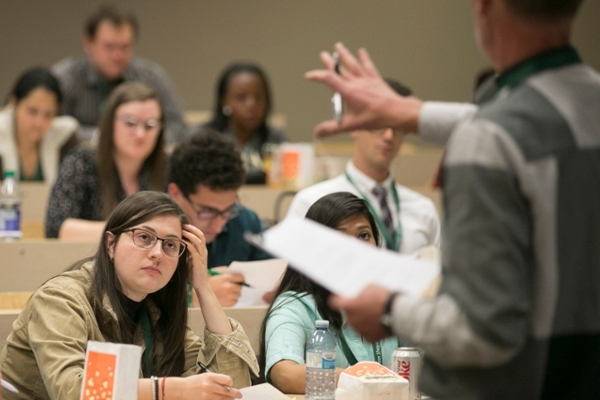
Is it Time for Shared Sacrifice at Post-Secondary Institutions?
This issue of JSGS Policy Brief is part of a series dedicated to exploring and providing evidence-based analysis, policy ideas, recommendations and research conclusions on the various dimensions of the pandemic, as it relates here in Canada and internationally.
By Dale Eisler, Senior Policy Fellow, Johnson Shoyama Graduate School of Public PolicyThe scope of the challenge universities face from the COVID-19 pandemic is multi-dimensional and still unfolding. But a few consequences, at least for the near-term, are certain. One is the move to remote course delivery, with in-person classes considered too risky in the current public health environment. Another is that gatherings such as convocation cannot proceed. A third is that grading has to be flexible and take into consideration the extraordinary circumstances faced by students. But for the most part, those are small and manageable. The institutions are still functioning, although at a suboptimal level.
The elephant in the room is money, or more specifically the loss of revenue. If universities, colleges and polytechs suffer the hits to their bottom line that some predict, uncomfortable questions need to be asked about the responsibility of faculty and administration to carry their share of the financial burden.
It is too early to know with precision how big the financial impact from the pandemic will be on post-secondary institutions. The consensus is it will be significant, and in some cases extreme enough to threaten their financial viability. The key factor is the potential for lost revenue from international students’ tuition, which in many cases is essential for universities to meet their operational needs. How big a risk is this? Huge. In the UK, where some are predicting a financial tsunami will hit the post-secondary sector, some institutions are preparing for an 80-100 per cent decline in international students.
In Canada and elsewhere, international students pay a vast differential over domestic students.1 On average in 2018, international students paid more than $25,000 in tuition, compared to about $7,000 for domestic students. With a premium like that, not to mention ancillary revenues from student residences to food, it’s little wonder that universities put a great deal of emphasis on attracting students from outside the country. From 2000 to 2018, international student enrolment in Canada grew from less than 45,000 to almost 300,000.2 On average, Statistics Canada reports that international students make up 12 per cent of overall enrolment.3 At some universities, for example Cape Breton University where international students represent more than 50 per cent of enrolment, that percentage is considerably higher and any reduction in it will have an immediate and serious impact on their viability.
Things can change, and hopefully they will in the coming weeks and months. Perhaps international numbers will hold up, as students outside Canada register for online delivery of courses. But the potential for a massive loss in international student enrolment in the fall is not only possible, but likely. Travel restrictions, the inability to secure student visas and the public health dangers of student mobility across international boundaries could very easily lead an evaporation of international student numbers and the tuition they pay. Assuming the 12 per cent enrolment average, and a 350 per cent tuition premium they pay for attending a Canadian university, it amounts to a massive and crippling loss in revenue.
A complicating factor has been declining financial support from government. Three years ago, the universities faced a cut in their operating grant from the Saskatchewan government. Since then the annual grant has been frozen, and this year received a one per cent increase. The net result has been that government funding as a percentage of the universities total revenue has fallen by four per cent in the last four years.
So, couple that with a major loss in revenue from international students, which has been critical to maintaining financial stability, and big trouble lurks. The issue is what to do about it, and how is the burden distributed? With salaries making up 75 per cent of operating budgets and tuition already at levels many students say are already too high, the answer is obvious. It’s job losses for support staff and salary reductions, coupled with the possible elimination of highly-paid administrative positions.
But what about tenured faculty, who make up a large proportion of salary costs? Should they be unscathed and leave others left to bear the full brunt of the looming financial crunch? Or should there be a collective approach, where no one group of people exclusively suffers the consequences, whether it’s through the outright loss of their job, or a significant reduction in their salary?
Those are questions that expose an issue common to universities. Namely the reality of social inequity that is part of the institutional culture. It is certainly not unique to universities, and is often common in large bureaucratic institutions. What makes universities unique is that, as institutions of higher learning, faculty are considered indispensable, which is self-evidently true. You can’t teach without teachers. Whereas many others, mostly support staff, are dispensable.
So those who happen to be the most vulnerable, often lower paid staff members, are the first to bear the cost of a financial problem that needs to be resolved. They get fired. Faculty members protected by tenure and collective bargaining agreements do not bear any financial burden resulting from the loss of enrolments. Indeed, in most cases they continue to receive annual raises—while other university employees are laid off.
But we are now in extraordinary times. The COVID-19 pandemic has changed the calculation and we’re told that we’re all in this together. Of course, that’s a nice slogan, but far from true. Tell that to a small business owner whose livelihood has just disappeared, or a worker in the service industry whose job is gone and has no benefits. For that matter, tell that to a laid-off support worker at a university.
You would think that if the dire financial predictions turn out to be true, perhaps now is a time for a show of solidarity on university campuses. Perhaps faculty, whose average salaries are well into the six figures, should step up and say it’s time for some social and economic justice in the workplace. Rather than seeing their colleagues suffer the dire consequences of unemployment, maybe the burden could be shared by the many instead of the few. The salary loss itself could be categorized as a donation to the institution, so that pensions are protected. Or there could be furloughs for faculty, who remain on staff but take unpaid leaves.
Maybe, just maybe, faculty and senior administration would finally find common cause in something. Maybe, as in the case of the University of Regina, they would give meaning to the words that are part of the university’s strategic plan: “Together We Are Stronger”. Maybe at the University of Saskatchewan, where “boundless collaboration” is one of its three commitments, it will be seen as actually true. Maybe instead of the few losing their jobs, the many would take a haircut. The answer will come in the weeks and months ahead.
Download the Policy Brief pdf.
ISSN 2369-0224 (Print) ISSN 2369-0232 (Online)
Dale Eisler

Prior to joining the JSGS, Dale Eisler spent 16 years with the Government of Canada in a series of senior positions, including as Assistant Deputy Minister Natural Resources Canada; Consul General for Canada in Denver, Colorado; Assistant Secretary to Cabinet at the Privy Council Office in Ottawa; and, Assistant Deputy Minister with the Department of Finance. In 2013, he received the Government of Canada’s Joan Atkinson Award for Public Service Excellence. Prior to joining the federal government, Dale spent 25 years as a journalist. He holds a degree in political science from the University of Saskatchewan, Regina Campus and an MA in political studies from Vermont College. He also studied as a Southam Fellow at the University of Toronto, and is the author of three books.

